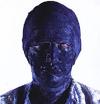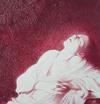Press and Media
San Francisco Chronicle – July 9, 1992
An artist reminds society of its past
German Portraits of Pain
Frankfurt, Germany.
It was night on the Autobahn and I was going to see Gottfried Helnwein, an artist known as "The Razor-Blade Rembrandt."
The artist's assistant, Heinz, was pushing the new Mercedes to 100 miles an hour.
This unnerving high-speed delivery, on a highway built by Hitler, seemed an appropriate prelude to meeting an Austrian whose art is a biopsy of post-war Germany, with references to resurgent fascism, mass insanity, suicidal depression and childhood trauma.
Leaving the Autobahn, we sped through dark countryside, gunned the car up a hill, and ground to a halt in the gravel. Above us loomed Helnwein's schloss. In New York, successful artists live in lofts. In Los Angeles they live in beach houses. In Germany they live in castles.
The front door swung open to reveal Gottfried Helnwein, standing well over six feet tall, dressed in double-breasted blue blazer, blue jeans and motorcycle boots.
Inside, the studio is a vast ballroom filled with anatomical models of human organs, stuffed birds, an insect collection and hundreds of 19th century surgical instruments.
Helnwein's signature image is a self-portrait of a bandaged man who screams as his eyes are punctured with forks. Helnwein has worked his icon into various pictures, transforming the self-portrait into a suffering Everyman beset by a world of ugliness, cynicism, senseless violence and pain.
The image reappears in tightly etched watercolors and huge abstractions. Helnwein also wraps himself in bandages, dumps paint on his head and photographs himself against backgrounds -- bombed-out Berlin, a hazy portrait of Hitler, a Weimar-era brothel.
Helnwein also is a portrait photographer. The walls of his studio are lined with three-foot-high black and white prints of Andy Warhol, Norman Mailer, Charles Bukowski, William Burroughs, Clint Eastwood, Mick Jagger and former West German President Willy Brandt.
Three Generations of Art
One of the most striking portraits is of 92-year-old Arno Breker, Hitler's official artist, who died recently. Helnwein convinced Breker to hold up a photograph of the late Joseph Beuys, Germany's most influential post-war artist. The picture freezes three generations of art in Germany in one bizarre moment.
The prices of Helnwein's work have soared to $20, 000 for drawings and more than $100,000 for his large canvases. He has exhibited in museums throughout Europe, but he is only now becoming known in the United States.
Helnwein also designs sets for plays in Cologne, Heidelberg and Munich. A 1985 German television film on Helnwein won accolades, and he recently produced a book of Berlin photographs with the late Marlene Dietrich.
Helnwein's influences include early German and Dutch masters, Goya, comic strips and rock and roll.
Helnwein was born in Vienna in 1948. "It is the most disturbed city I know. On the surface it is sugar and spice, elegant and civilized. Underneath Vienna is crazy, sick, insane. There are more insane people in that city than in New York . . . For me, childhood was all wrong. It was a dark, bleak time in the early ë50s after the war ended. Then, I remember, my father brought me my first Mickey Mouse comics -- I was 6 years old. There was something so fresh and happy about that little mouse. It changed my life. I began to draw cartoons."
He was trained classically in Vienna by Rudolf Hausner, but saw himself outside the mainstream. In the ë60s and ë70s, he and other students staged Aktions, or happenings, in the Vienna Academy and in the streets. In one, he lay down on the sidewalk, heavily bandaged, begging for help. "The idea was to just wake people up, to break through their indifference."
In his graduation exhibition at the Vienna Museum, his paintings were defaced by Nazi stickers denouncing "decadent art". At a gallery in Modling the mayor ordered constables to confiscate his paintings.
In 1971 he began his bandaged children series. "This country, Austria, was a depressing place after the war to be a child. No singing, lots of guilt, little play. I painted the children to bring a focus to them and their sufferings."
Helnwein's images often appear on the covers of magazines, from Stern to Rolling Stone. His first cover, for the Austrian magazine Profil in 1973, depicted a girl jumping out a window to illustrate suicide in Austria. "The magazine was scared to print the picture at first. In fact the art director printed it at the last minute without telling the publisher. The magazine received more letters and phone calls -- and cancelled subscriptions -- then they'd had in years."
Poisoned Children
In 1979, Helnwein was outraged to learn that Austria's premier forensic psychiatrist, Dr. Heinrich Gross, had admitted in an interview to having poisoned hundreds of sick children in the '40s "for the good of society." Helnwein painted a picture of a dead child lying face down in a dish of food, titled it, "Life Unworthy of Living," and sent it to a local newspaper.
Not all Helnwein's images make viewers wince. His sketches include hares, booted cats and bears raiding a honey tree. In 1977 Helnwein spent seven months in America studying Disney's images. He reveres Donald Duck's creator, the late Carl Barks, and owns more than 200 original drawings of Donald Duck.
Helnwein's manager is his wife of 20 years, Renate Helnwein. His three children, Cyril, Mercedes and Ali, pose for their father's bizarre work and often paint alongside him.
Helnwein moved to Germany in 1985, and raised a commotion in 1988 when he installed "Ninth November Night," a 300-foot long picture series outside the city's Ludwig Museum that commemorated Kristallnacht, the Nazi roundup of Jews on Nov. 9, 1938. The giant photographic portraits of children recalled the photos made for concentration camp selection. One evening, the throats were cut on all he faces. Helnwein left the slashed canvases unrepaired, as evidence of latent Nazism.
Barnaby Conrad III


